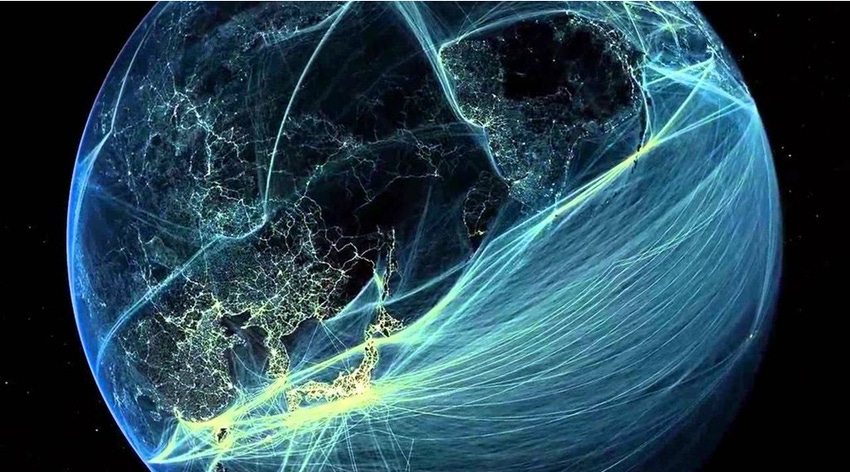How the 4th Industrial Revolution will impact packaging, part 1
December 20, 2017

Sustainable packaging strategies will need to adapt to the massive restructuring of the retail industry, a shifting global logistics infrastructure and a changing notion of consumption itself. Kelly Cramer zooms out—way out—to explain why and how industry can reconsider packaging for the next era of production.
[Read "How the 4th Industrial Revolution will impact packaging, part 2" here. ]
The world is changing as we enter the Fourth Industrial Revolution.
You don’t have to look far in the media, or even within your own immediate surroundings, to see that the world is changing by grand leaps―and with haste. Some, such as those at the World Economic Forum, are characterizing the many changes seen in the last few years as the Fourth Industrial Revolution (aka Industry 4.0). Building upon the Third Industrial Revolution of the internet and automation (that is still ongoing), the Fourth Industrial Revolution is marked by advancements that fuse the physical with the digital. Robotics, the Internet of Things (IoT), 3D printing, advanced materials and artificial intelligence are all examples of this. Every industry will be disrupted with a velocity, scope and systems impact that has never been seen before.
Due in part to changing behaviors and desires, consumption is changing.
Among the areas that will be change by this revolution, and that is already changing before our eyes, is the notion of consumption itself. What people are consuming, how and when they’re consuming it, and where the consumption takes place is changing quickly. The astronomical rise of ecommerce is the most obvious aspect of changing consumption, but there are other compelling changes, including the explosion of subscription products, the success of brands with super-fast production cycles and the growth of the sharing economy.
As a result of these new sales channels and an evolving consumer experience, we’re observing greater customization of products, better accessibility to products, the prioritization of convenience, and more engagement between consumers and brands.
As consumption is changing, the systems of production are also changing.
Due at least in part to these changes in consumption, we’re observing a fundamental restructuring of the retail industry that is in process right now. What’s happening right now isn’t just “American malls have too much real estate vacancy.” Anyone who sells anything―not just the apparel companies or department stores in headlines―will be impacted by the consumption evolution. The idea of what a store is may change considerably in the coming years as shopping becomes more digitized and multidimensional. Like journalism before it, the consumer packaged goods (CPG) industry will likely get “leaner and meaner.”
The shift in the sale of goods to new channels and consumption habits is very much related to the global shift in logistics. The way things move through our world is being optimized, automated and reshuffled. Additionally, manufacturing and supply chains are becoming smarter, more agile and interconnected.
Sustainability is a new standard and expectation in production and consumption.
In addition to systems changing, circular economy and sustainability have become key considerations in the modern business model. The rise of the aspirational consumer (who places high value on environmental responsibility), combined with the disproportionate and unprecedented buying power of the millennial generation (that loves sustainability), means that every day you’re not investing in sustainability you’re losing much longer time down the road to catch up. If you’re able.
Because packaging touches all products, and because consumption and production are fundamentally changing, packaging will also fundamentally change.
Packaging is connected to the sale of all products; it is the common material thread between all things sold. Packaging must first and foremost protect the product. If packaging fails and the product gets damaged, you lose the entire capital, environmental and human investment that went into making that product. Often, the “footprint” of packaging is much less than the actual product itself.
For this reason, studying how the packaging relates to and interacts with the product―or in other words, analyzing “the product/packaging system”―is essential to creating sustainable packaging. A package is well-designed so long as the amount of material used in packaging is enough to protect the product but no more.
The role of packaging in the ecommerce channel enables something much different from packaging than traditional retail does. This past spring at the Sustainable Packaging Coalition’s conference SustPack, Dr. Kim Houchens and Brent Nelson of the Amazon packaging sustainability team explained how products that move through Amazon fulfillment are handled on average 20 times, versus the minimum of five for brick-and-mortar retail. And while the product isn’t handled individually until it reaches the shelf at a brick-and-mortar store, in Amazon fulfillment centers, pallets are broken down into individual units much earlier in the process, and re-aggregated into shipping packages for each unique customer order. And because packaging doesn’t move with a certain side facing up in ecommerce, it means that certain fragile products like liquids sometimes need to be packaged differently to prevent leakage. This shows that you’re hiring packaging to do a very different job in ecommerce than you are for traditional retail.
The traditional product/packaging system will struggle in the Fourth Industrial Revolution if it doesn’t adapt fast enough to the new demands put on it―but these changes can also set packaging free.
One way that the traditional product/packaging system is falling short in ecommerce is in product damage rates. Amazon is encouraging its vendors to think seriously about avoiding product damage, because it creates a terrible customer experience. Specifically, the etailer has worked with ISTA to develop a test to simulate how packaging moves throughout the Amazon fulfillment process. It includes two hours of vibration, 17 simulated edge corner face drops and a leak integrity test.
Amazon has also developed the Frustration-Free Packaging program to encourage brands to package product in a way that doesn’t require an Amazon box, and can be sent direct to the consumer without being repackaged in the fulfilment centers, potentially helping mitigate damage and also helping save materials.
One could argue that traditional retail in some ways holds sustainable packaging back―because of prevailing marketing conventions. Brands want shelf presence, which may mean excess materials to “increase real estate” and flashy labels or inks that could negatively impact recyclability. But as Amazon has emphasized, expensive “romance” packaging isn’t required to draw the consumer’s attention in ecommerce; it’s the product, not the packaging, that is displayed to consumers online when they buy, so the consumer doesn’t need to touch or feel the packaging to make a purchase decision (packaging functionality, however, is still critical for the consumers’ usage experience). Additionally, the need of theft protection no longer being relevant will also help companies use fewer materials.
Another significant challenge to the traditional product/packaging system is the newer dimensional weight pricing rules from the big carriers like UPS and FedEx that will make it significantly more expensive to ship larger volume packaging (air, that is) direct to the consumer. Changing logistics costs will add complexity to the product/packaging system, but overcoming these challenges will provide significant carbon benefits. In this sense, packaging sustainability will be more tied to logistics sustainability than before.
Another interesting possibility is when and if the need for more sustainable packaging and the cost of logistics ends up changing the products themselves. One classic example is movement toward concentrates to avoid shipping water, but we’re seeing flashes of an exciting new horizon with Amazon’s plunge into microwave assisted thermal sterilization (MATS). We may not need into ship ice packs if, in the future, we’re eating more food that doesn’t require refrigeration. Packaging will be at the forefront as processing technologies, changes to the products themselves and the tightening of logistics efficiencies dramatically reconfigure the product/packaging/process system.
Part 2 of this series will examine what industry can do about adapting packaging for this next era of production.

Kelly Cramer is a senior manager at GreenBlue and the Sustainable Packaging Coalition, where she leads one of its fastest growing projects, the How2Recycle Label program. She comes to GreenBlue with a background in public interest advocacy and a J.D. in Environmental Law from Lewis & Clark Law School in Portland, OR, as well as a deep passion for writing and design.
**********************************************************************************
Learn about the latest developments in sustainable packaging at MinnPack 2017 (Nov. 8-9; Minneapolis). Register today!
About the Author(s)
You May Also Like


